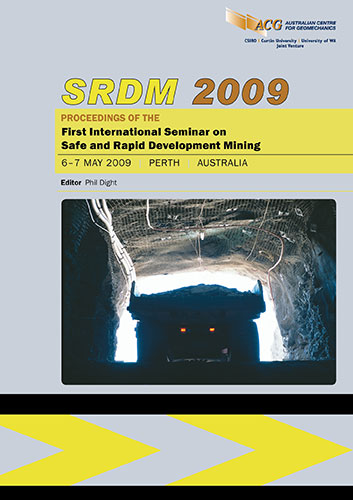Modern tools and equipment for tunnelling and drifting

|
Authors: Schunnesson, H Paper is not available for download Contact Us |
DOI https://doi.org/10.36487/ACG_repo/902_13
Cite As:
Schunnesson, H 2009, 'Modern tools and equipment for tunnelling and drifting', in PM Dight (ed.), SRDM 2009: Proceedings of the First International Seminar on Safe and Rapid Development Mining, Australian Centre for Geomechanics, Perth, pp. 139-148, https://doi.org/10.36487/ACG_repo/902_13
Abstract:
Tunnelling is a key activity in infrastructure projects and in mine development and production. The speed of tunnelling has always been important, especially in underground constructions, where profit is often linked to how fast the job can be done. This is also valid for development in the mining industry. However, for the miner the situation is sometimes different, in that his ambition is to fulfil ore production targets with as small an input of resources as possible. This means that the main objective has been the utilisation of machinery and labour. In the mine development phase, on the other hand, a rapid access to the orebody is crucial, since it will yield a quicker pay back of the investment. Even if rapid development advance is a priority, it is important to recognise that modern tunnelling technique and equipment can provide additional benefits including: production control, improvement in tunnel and profile quality, characterisation of the surrounding rock mass, etc. During the past few years increased focus has been placed on communication technology improving the flow of information to and from the rig. Information on production, quality, maintenance, ground characterisation, etc., can be supplied by the rig if the technical framework is present. Logging functions have also been extended and can now provide detailed information on production, drill hole quality, the maintenance requirements and drill monitoring for geological and geotechnical characterisation of rock mass ahead of the face. Computerised drill plan design enables a drilling sequence to be designed by computer based on the tunnel design for each section. This technology is now in use and can assist with quality control such that the tunnel will be constructed according to the design with a minimum of over break. The risk of mistakes and faults is minimised and the rig navigation is the only weak point in the chain. This paper presents the state-of-the-art in equipment and tools for tunnel construction, and discusses the benefits available through better process quality control, better tunnel design control and improved knowledge of the surrounding rock mass and the rock mass ahead of the face.
References:
Atlas Copco (2009) Tunnel Manager version 1.5. A support software package for planning, administration and analysis
of tunnelling projects.
International Electrotechnical Commission (IEC) (1990) 60050 (191): Dependability and quality of service, Geneva,
Karim, R. (2008) A Service-Oriented Approach to eMaintenance of Complex Technical Systems. Doctoral Thesis
2008:58, Luleå University of Technology.
Muller, A., Marquez, A.C. and Iung, B. (2008) On the concept of eMaintenance: review and current research. Journal of
Reliability Engineering and System Safety, Vol. 93, No. 8, pp. 1165–1187.
Parida, A. and Kumar, U. (2004) Managing Information is Key to Maintenance Effectiveness. Proceedings of the
Intelligent Maintenance Systems (IMS) 2004 International Conference, K.H. Adjallah (ed), July 15–17, Arles,
France. CD format only, 6 p.
Ramström, M., Toivanen, R-M. and Elsrud, R. (2005) Experiences with New Technology at the Kemi Mine in Finland.
Canadian Institute of Mining Annual General Meeting, Toronto, Ontario, April 25–27, 2005.
Schunnesson, H. (1998) Rock characterisation using percussive drilling. International Journal of Rock Mechanics and
Mining Sciences, Vol. 35, No. 6, pp. 711–725.
Schunnesson, H. (1996) RQD predictions based on drill performance parameters. Tunnelling and Underground Space
Technology, Vol. 11, No. 3, pp. 345–351.
Ståhl, E. (2005) Process and risk analysis of navigation of tunnel rounds. M.Sc. thesis 2005:302CIV, Luleå University
of Technology (In Swedish).
Tsang, A. (2002) Strategic dimension of maintenance management. Journal of Quality in Maintenance Engineering,
Vol. 8, No. 1, pp. 7–39.
© Copyright 2025, Australian Centre for Geomechanics (ACG), The University of Western Australia. All rights reserved.
View copyright/legal information
Please direct any queries or error reports to repository-acg@uwa.edu.au
View copyright/legal information
Please direct any queries or error reports to repository-acg@uwa.edu.au